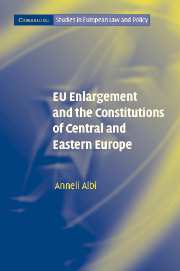Book contents
- Frontmatter
- Contents
- List of tables
- Series Editors' Preface
- Acknowledgements
- Table of cases
- Table of treaties, laws and other instruments
- List of abbreviations
- Introduction
- 1 Overview of the accession process
- 2 Constitutional adaptations in the ‘old’ Member States
- 3 Some idiosyncrasies of CEE constitutions
- 4 Constitutional issues in the pre-accession period
- 5 Revision of CEE constitutions for EU membership
- 6 Theoretical views of sovereignty and democratic legitimacy in CEE
- 7 Referendums
- 8 Membership of NATO and other international organisations
- 9 Role of Constitutional Courts
- 10 Implications of the European Constitution
- Epilogue: ‘Taking constitutions seriously’ in the process of European integration
- Bibliography
- Appendix
- Index
5 - Revision of CEE constitutions for EU membership
Published online by Cambridge University Press: 28 July 2009
- Frontmatter
- Contents
- List of tables
- Series Editors' Preface
- Acknowledgements
- Table of cases
- Table of treaties, laws and other instruments
- List of abbreviations
- Introduction
- 1 Overview of the accession process
- 2 Constitutional adaptations in the ‘old’ Member States
- 3 Some idiosyncrasies of CEE constitutions
- 4 Constitutional issues in the pre-accession period
- 5 Revision of CEE constitutions for EU membership
- 6 Theoretical views of sovereignty and democratic legitimacy in CEE
- 7 Referendums
- 8 Membership of NATO and other international organisations
- 9 Role of Constitutional Courts
- 10 Implications of the European Constitution
- Epilogue: ‘Taking constitutions seriously’ in the process of European integration
- Bibliography
- Appendix
- Index
Summary
Wider package of EU amendments
Slovakia
Having explored the constitutional background in CEE countries, the experiences in the ‘old’ Member States and the constitutional aspects of pre-accession adaptations, we will now turn to the central issue – the adaptation of constitutions of Central and Eastern European countries for membership of the European Union. We will start our inquiry into the chain of constitutional amendments across the region with the countries where the package of EU amendments was most comprehensive: Slovakia, the Czech Republic and Slovenia.
The process started in Slovakia, where the constitution is one of the easiest to amend amongst the countries in question: it requires the approval of a three-fifths majority of all deputies (article 84(4)). Amongst earlier amendments, the division of powers was modified in 1998, and direct presidential elections were introduced in 1999, at the same time curbing the President's prerogatives. These were followed in 2001 by a comprehensive revision of the constitution, which, inter alia, introduced reforms in respect of public administration, local government and the judicial system, created the institution of the ombudsman, clarified the separation of powers and prepared the country for membership of the EU and NATO. This package of altogether eighty-five amendments, produced by the Parliament's Commission for Constitutional Amendment which had been established in 1999 from amongst the deputies of the ruling coalition, was adopted by Parliament on 23 February 2001.
- Type
- Chapter
- Information
- Publisher: Cambridge University PressPrint publication year: 2005
- 1
- Cited by



